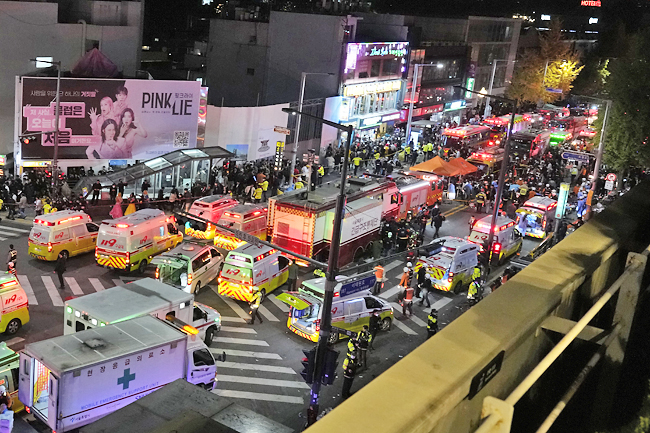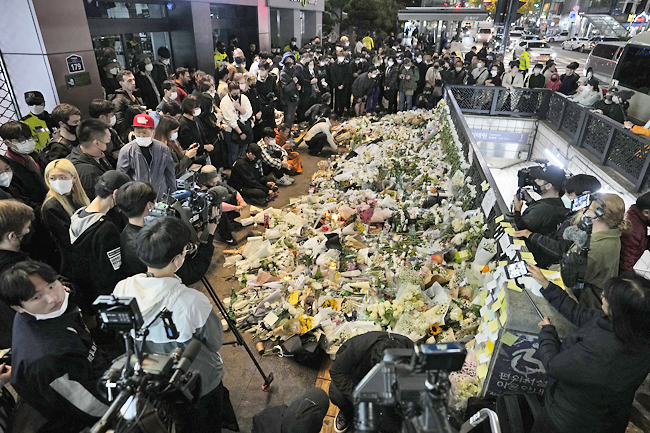SEOUL, SOUTH KOREA (AP) – When Kim Kap -soo watched live broadcasts of the harrowing Halloween party crush that killed more than 150 people in Seoul last weekend, there was shock and sadness – but also the embarrassed realisation that this wasn’t the first time he’d seen South Korea suffer a devastating disaster as a result of official incompetence and safety failures.
“My heart is aching very much. We are among the world’s 10 largest economies, and I totally don’t understand how this can happen in our nation,” said Kim, 73, a retired environmental engineering researcher.
“Our public insensitivity to safety is too severe. We should always be careful about everything, but we don’t do so, and I think that’s the biggest problem.”
The crowd crush in Itaewon, a popular nightlife district, has caused an outpouring of public sympathy toward the dead, mostly in their 20s and 30s, and demands for accountability for the tragedy.
But many also share a strong feeling of embarrassment and anger that their country, a cultural and economic powerhouse that has risen from war, poverty and dictatorships, still ignores safety and regulatory issues.
Similar crowd crushes have happened in other developed countries in recent years, but the death counts there were much smaller than in Itaewon, where 156 people died and 187 were injured.


There are growing questions here about why South Korea hasn’t learned its lessons since the 2014 sinking of the ferry Sewol, which killed 304 people – mostly teenagers on a school trip.
That disaster also prompted national soul-searching on the country’s failure to enforce safety and regulatory rules.
“When it comes to public safety, I think we aren’t an advanced nation at all, though we might have grown economically,” said Park You-nam, 60, who runs a jewellery shop. “I feel really sorry and guilty for those young victims because we all failed to protect them.”
From K-pop superstars BTS and Netflix’s megahit drama Squid Game to Samsung-made smartphones and Hyundai cars, South Korea’s recent cultural and economic achievements have been remarkable.
But there’s a dark side to its breakneck rise from the extreme poverty of the 1950 and 60s: Critics say basic safety practices, social safety nets and minority voices have been largely overlooked.
Not much has changed since the ferry sinking, these critics say, citing a series of smaller deadly incidents such as fires and boat accidents.
Last Tuesday, President Yoon Suk Yeol acknowledged that South Korea lacks studies on crowd management and ordered officials to formulate effective crowd control methods based on high-tech resources such as drones.
Police also said they don’t have guidelines to deal with crowd surges at events that have no official organisers, like the Halloween festivities in Itaewon.
Seoul National University Professor Park Sangin said the Itaewon crush showed that South Koreans haven’t done much to improve systems and policies to prevent similar man-made disasters like the ferry sinking. He said South Koreans have focussed instead on finding, criticising and punishing anyone responsible each time an incident occurs.
“For a country that has experienced many safety-related incidents, there should have been diverse studies and countermeasures to prevent their recurrences and that’s the responsibility of government officials and politicians,” Park said.
“But they haven’t done so, and I think it’s more important to criticise them to get things changed.”
What exactly caused the crush is still under investigation. But it happened when more than 100,000 partiers clad in Halloween costumes and others packed Itaewon’s alleys.
Police dispatched only 137 officers to the neighbourhood, mostly with a mission to deal with possible crimes such as narcotics use, not crowd control.
Police also acknowledged they had received about a dozen emergency calls from citizens about the impending crowd surge but didn’t handle them effectively.
The disaster has left many South Koreans with feelings of trauma. Witnesses said that people fell on each other like dominos, screamed, suffered severe breathing difficulties and lost consciousness while crammed into a sloped, narrow alley. TV footage showed people frantically giving CPR to victims lying motionless near a row of dead bodies covered by blue blankets.
“When I first saw such things on TV, I thought they were happening in a foreign country, not here,” said Kim Suk-hee, 40, a real estate agent.
“I was so stunned to learn that it was Itaewon, because I had actually planned to go there with my family for Halloween the next day. I still have trauma over what happened.”
Professor at Seoul’s Kookmin University Jang Seung-jin said the Itaewon crush proved again that South Korea still has a long way to go to become an advanced country in all aspects. He said what’s important now is how the country will handle the aftermath.
Since the disaster, some top officials have been severely criticised over comments that were seen as trying to avoid government responsibility for the crush or even joking about it. A public survey taken after the disaster shows President Yoon’s approval rating is about 30 per cent, a very low rate given he took office only six months ago.
His future popularity could depend on how he handles the Itaewon tragedy, said Director of the Seoul-based Institute of Presidential Leadership Choi Jin.
At a Seoul mourning centre, Vietnam war veteran Park Young-kee, 82, laid white flowers and bowed to the memory of the dead, including a distant relative who was a high school student. “This kind of disaster didn’t happen when I was young. I can’t describe how I feel,” Park said.
“This occurred because we are not an advanced country. If we are really an advanced country, could it have happened?”






